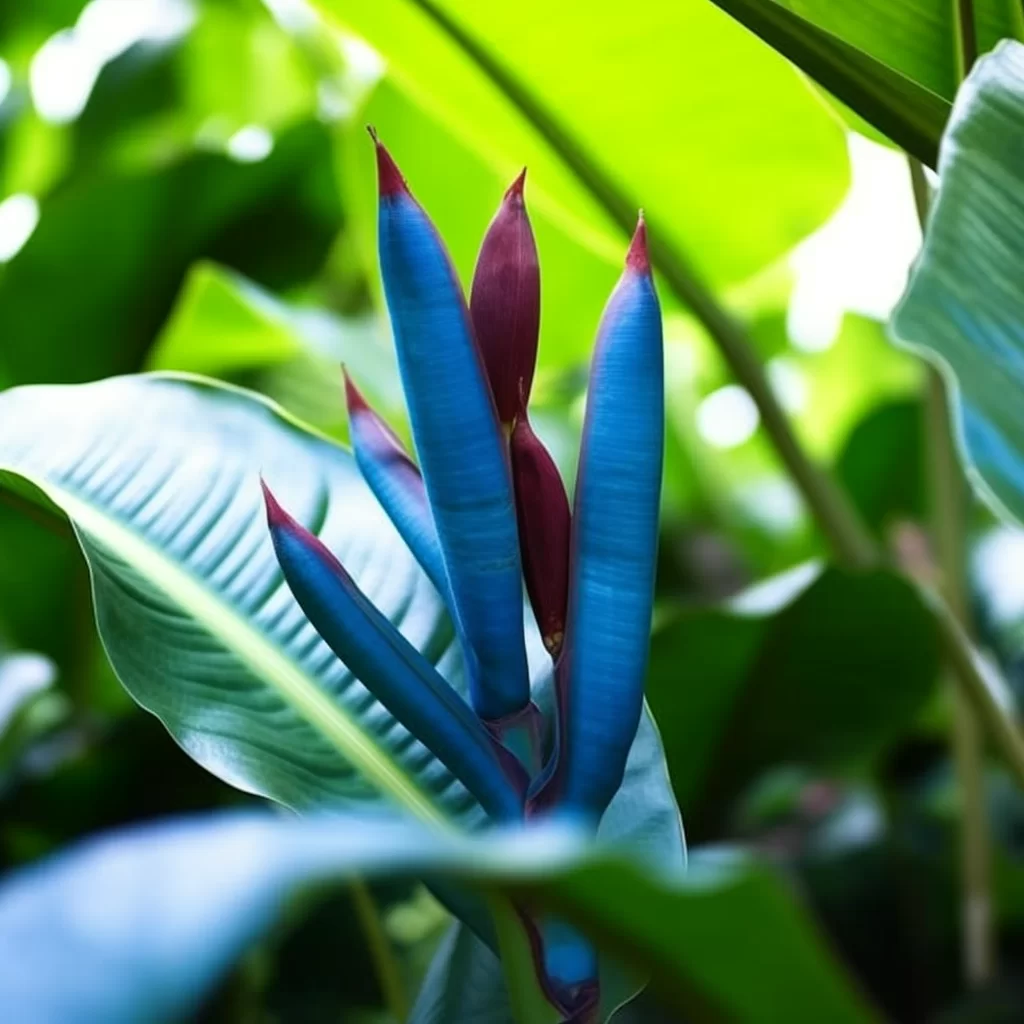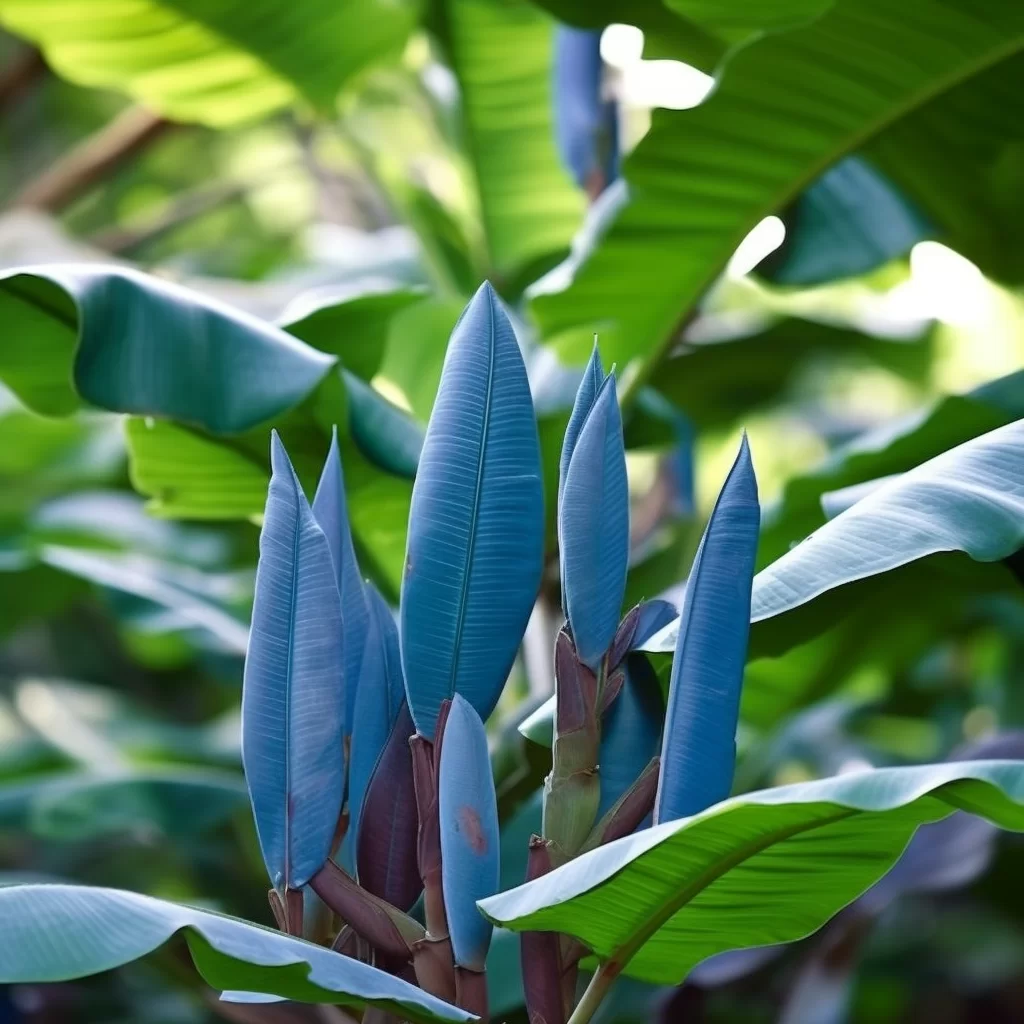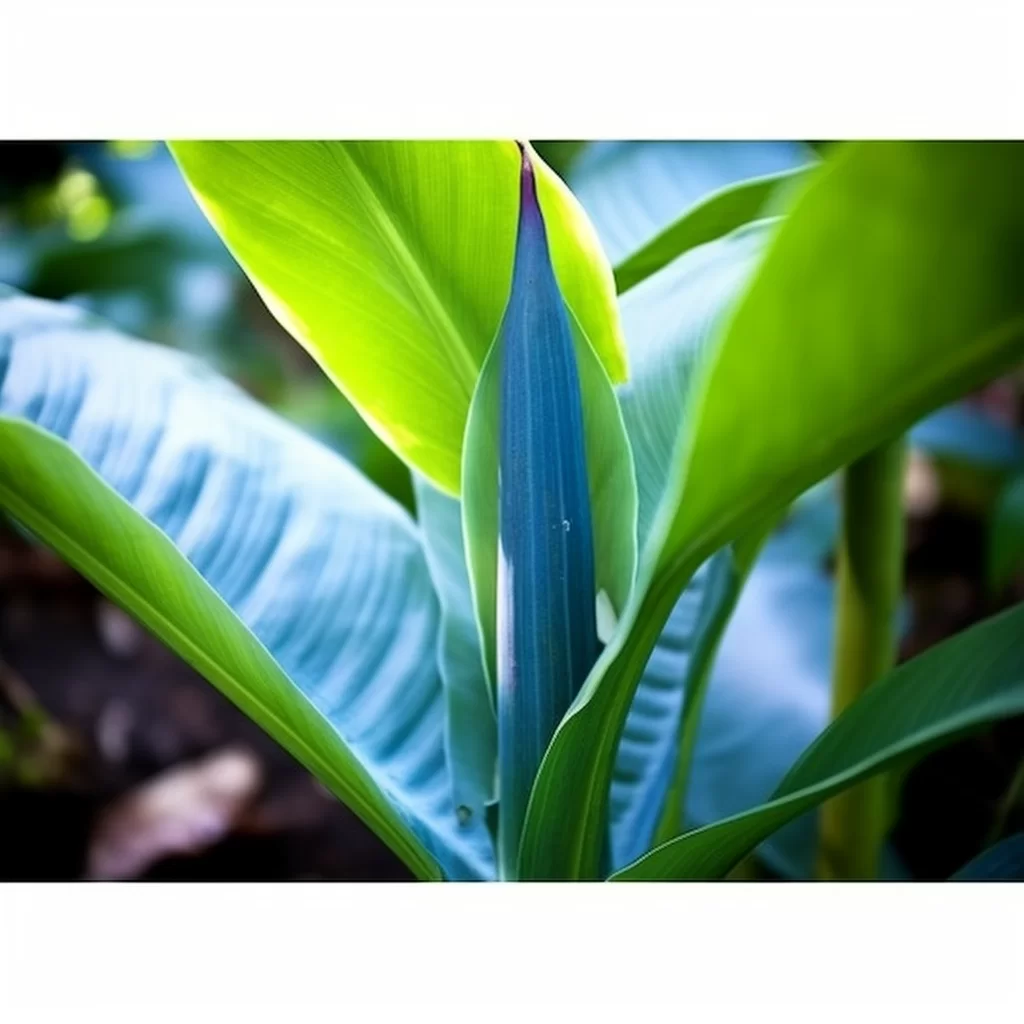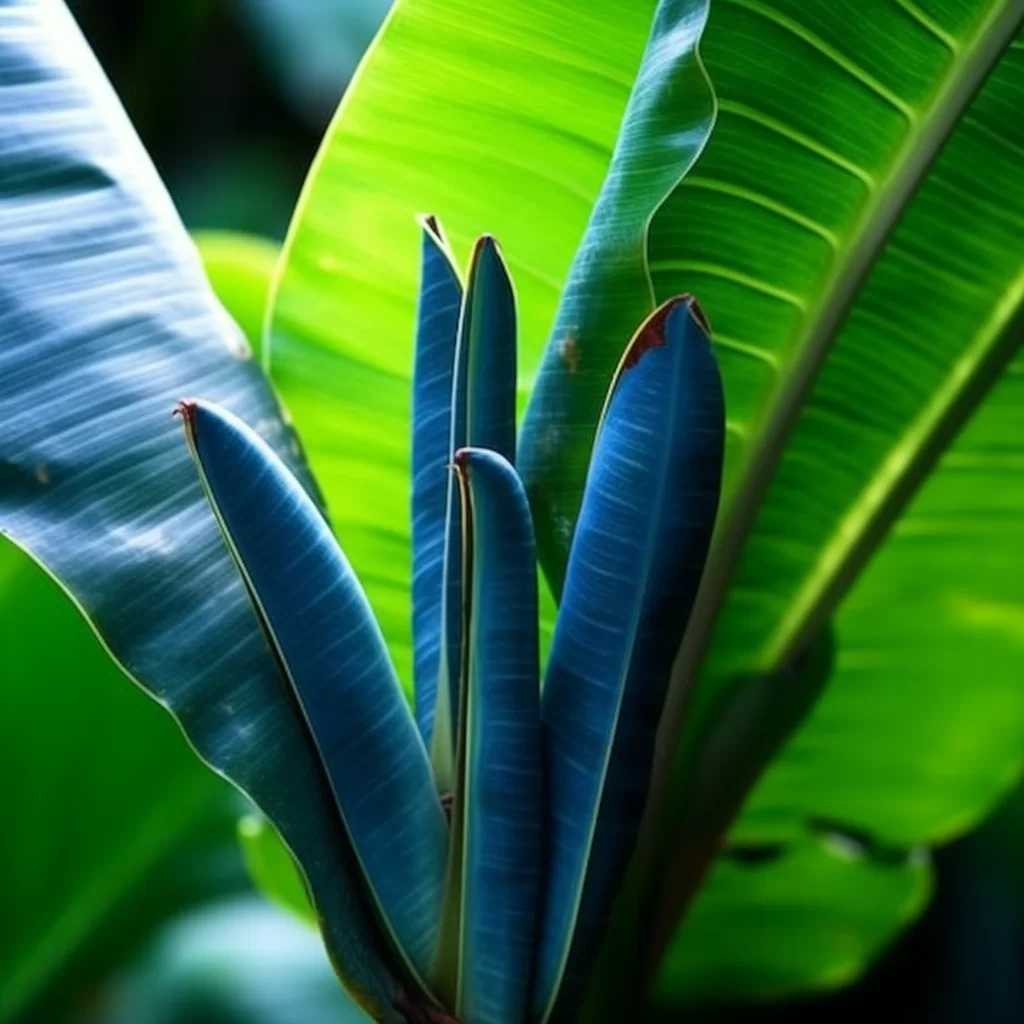Story of Day :
Contents
The Blue Java Banana Plant: A Complete Guide and Care Tips
If you’re a gardening enthusiast who’s always on the lookout for something new to add to your garden, then consider getting yourself a Blue Java Banana plant.
Not only does it offer an exotic touch with its striking blue-green leaves, but it also bears delicious fruit that’s sure to satisfy your taste buds.
The Blue Java Banana is also referred to as the Ice Cream Banana because of its creamy consistency and sweet flavor, making it a popular choice among gardeners.This tropical tree is perfect for those who have a passion for gardening and are looking for something unique to add to their collection.
Its lush foliage and interesting features make this species stand out among other plants in any outdoor setting or indoor space with enough light.
With proper care, you can enjoy the beauty of its leaves while indulging in its delectable fruit, making it an all-around excellent addition to any garden!
Origins of the Blue Java Banana Plant
The Blue Java Banana plant is a tropical plant that originated from Southeast Asia and was first planted in the Philippines.
It has since been introduced to other parts of the world, including Hawaii and Central America.
The plant’s unique name comes from its striking bluish-green leaves and the texture of its fruit.
Speaking of which, the fruit itself is commonly compared to vanilla ice cream due to its creamy consistency and sweet flavor. If you’re lucky enough to come across this rare banana variety, you’ll find that it’s not only delicious but also quite versatile.
If you’re lucky enough to come across this rare banana variety, you’ll find that it’s not only delicious but also quite versatile.
You can use the fruit in smoothies or desserts, or simply enjoy it as a snack on its own.
And don’t forget about those eye-catching leaves! They make for an excellent ornamental addition to any garden.
So whether you’re interested in trying out something new in your kitchen or looking for a beautiful new plant for your yard, be sure to check out the Blue Java Banana!
Growing Conditions
The Blue Java banana plant is a unique and fascinating species that requires specific conditions to flourish.
To ensure its survival, the plant needs warm temperatures ranging from 60 to 80 degrees Fahrenheit, making it suitable for tropical areas.
Additionally, it thrives in well-draining soil with plenty of organic matter that provides essential nutrients to the roots, allowing them to grow strong and healthy.
One crucial thing to note is that frequent watering is necessary for this species as they need moist soil throughout their growth cycle.Standing tall at 15 feet, the Blue Java banana tree boasts large leaves measuring up to an impressive 9 feet long! This makes it a beautiful addition to any garden or outdoor space.
Its lush foliage creates an excellent canopy providing shade during hot summers.
Besides its aesthetic value, this unique plant could be an exciting option for cultivation due to its hardiness and adaptability under different conditions.
Overall, growing the Blue Java banana tree is not only rewarding but also satisfying as you get a chance to witness its stunning growth journey firsthand!
 Banana plants are a tropical species and demand a minimum of six hours of direct sunlight every day.
Banana plants are a tropical species and demand a minimum of six hours of direct sunlight every day.
They prefer warm temperatures and can be planted close to south-facing walls or fences, which can provide protection against cold weather in the winter months.
However, if you live in an area where it is difficult to maintain consistent warmth throughout the year, you may want to consider growing banana plants indoors or in a greenhouse during cooler months.
In such cases, it is essential to supplement their lighting requirements with additional grow lights for optimal growth.It is crucial to understand that bananas require plenty of sunlight as they are photosynthetic organisms that rely on the energy from the sun’s rays for growth and development.
Even though they can tolerate some shade, it is best not to compromise on their light requirements if you want healthy banana plants that produce fruit regularly.
By planting them near south-facing walls or using supplemental lighting indoors, you can ensure your plants receive enough light and thrive all year round.
Taking care of your banana plant’s lighting needs will help increase its chances of producing delicious fruit for years to come!When it comes to growing plants, the soil you use is essential.
To ensure healthy root growth, it’s recommended that the soil has good drainage capabilities while also retaining moisture.
To achieve this balance, organic matter such as composted leaves or topsoil can be added to the soil every two to three months.
Additionally, the pH level of the soil should fall between 5.5 and 7 for optimal growth results; if it falls outside of these levels, adding sulfur or lime can help get it back on track.It’s important to remember that different plants will have varying requirements when it comes to their ideal pH level and type of organic matter needed for healthy growth.
However, by following these general guidelines, you can set a solid foundation for your garden beds and ensure that your plants have the best chance at thriving.
Watering Requirements
- The banana plant needs the equivalent of 1 inch of rainfall per week or consistent watering amounting to about an inch of water weekly.
- The tree will need more frequent watering during hot, dry periods or if planted in sandy soils with poor water retention.
- Avoid overwatering which can cause root rotting and other fungal issues.
Care Tips for Blue Java Banana Plant
If you’re up for a challenge, growing a Blue Java Banana plant is definitely worth the effort.
It may take some time and patience, but seeing this magnificent tree bear fruit is truly magical.
However, caring for your banana plant requires some specific attention to detail.To ensure that your Blue Java Banana thrives, make sure to keep it in a warm and humid environment with plenty of sunlight.
Water it regularly and fertilize every few months to ensure optimal growth.
It’s also important to protect your plant from pests and disease by inspecting it frequently and treating any issues promptly.
With these essential tips in mind, watching your Blue Java Banana grow into its full potential will be an incredibly rewarding experience!
 When it comes to growing healthy plants, fertilization is crucial.
When it comes to growing healthy plants, fertilization is crucial.
Fertilizers provide essential nutrients that plants need for growth and development, such as nitrogen, phosphorus, and potassium.
These nutrients can become depleted over time in the soil as the plant absorbs them for its own use or if they are washed away by rain or irrigation.
Different types of plants have different fertilization needs depending on their stages of growth and their natural preferences for certain nutrients.
For example, flowering plants often require more phosphorus to support the development of blooms while leafy vegetables benefit from a higher nitrogen content to encourage vigorous leaf growth.
It’s important to carefully consider a plant’s individual needs when selecting a fertilizer and to follow application instructions closely in order to avoid damaging roots or overfertilizing which can lead to excessive foliage at the expense of fruit production or even death of the plant itself.
- Fertilize with high-nitrogen fertilizer every four weeks during growing season
- Potassium-rich fertilizers promote flowering and fruit production; apply biweekly.
- Magnesium promotes leaf health- sprinkle epsom salt around the plant’s base once a month.
Pest control measures are vital in ensuring the safety and health of living spaces.
Pests such as rodents, ants, cockroaches, bed bugs, and termites can cause extensive damage to buildings and transmit diseases.
To prevent pest infestation, several measures can be taken.
The first step is to keep the living space clean by removing food waste promptly and keeping floors clean.
Secondly, sealing cracks and gaps that pests use as entry points is important in preventing their access into the house.
Additionally, it is essential to store food safely in air-tight containers to minimize pest attraction.In case of a severe infestation despite preventative measures put in place at home or commercial spaces like hotels or restaurants professional exterminators should be contacted for pest control services.
These experts have knowledge on how best to handle different kinds of pests effectively using safe yet potent methods such as baiting traps with poison baits or spraying insecticides where needed while observing safety precautions such as wearing protective gear when applying pesticides.Overall taking preventative measures against pests helps save money that would have been spent on costly repairs while also keeping homes safe from diseases associated with pests like rats which may cause leptospirosis among other illnesses transmitted by rodents defecating on surfaces they come into contact with regularly.
The Blue Java Banana plant is a popular tropical species among home gardeners.
However, it is susceptible to attacks by several pests, including aphids, mealybugs, mites, thrips, and spider mites.
These pests can cause significant damage to the plants if not kept in check.
One way of managing pest infestations is by conducting regular inspections of the plants to detect any early signs of infestation.
Additionally, keeping the surrounding environment clean by removing fallen leaves and debris can help prevent breeding grounds for insects like red spider mites.To mitigate pest infestations on Blue Java Banana plants further, consider implementing some preventive measures such as using natural or chemical insecticides or introducing beneficial insects that feed on pests.
It’s important to note that different pests may require specific treatments for effective control; therefore, it’s advisable to identify the type of pest before applying any treatment method.
With proper care and management practices in place, your Blue Java Banana plant will thrive healthily without being threatened by pesky invaders!
When it comes to harvesting crops, there are a few key things to keep in mind.
Firstly, it’s important to time your harvest carefully.
Different crops have different optimal times for harvesting, and you’ll want to make sure you’re picking them at just the right moment in order to get the best possible yield.
Secondly, you’ll need to use the right tools for the job – whether that means hand-picking produce or using machinery like combine harvesters.Once your crops are harvested, proper storage is essential if you want them to last as long as possible.
This means keeping them in a cool, dry place where they won’t be exposed to sunlight or moisture that could cause mold or spoilage.
Depending on what kind of crop you’re storing and how long you need it to last, there may be additional steps involved – such as curing onions or potatoes before storing them long-term.
By following these tips and taking good care of your harvested crops, you can ensure that they stay fresh and delicious for as long as possible!
Bananas take between six to eight months after planting before they are ready for harvest.
The banana bunches should be harvested when the fruits are still green but show signs of maturing, such as a yellowing color on the tips.
Here are some tips for harvesting and storage:
The harvesting process is a crucial aspect of agriculture that involves the collection and preparation of crops for consumption or sale.
It usually begins with the identification of mature crops that are ready for harvesting, followed by the use of appropriate equipment to cut or pull them out from their roots.
The harvested crops are then sorted, cleaned, and packaged according to their specific characteristics to ensure quality and freshness.Different types of farming methods may require different harvesting techniques.
For instance, some fruits and vegetables can be hand-picked in small quantities while others require more significant mechanized efforts to harvest large volumes efficiently.
Additionally, factors such as weather conditions and market demands may influence the timing and pace of harvesting activities.
Overall, an efficient harvesting process plays a critical role in ensuring a steady supply chain that meets consumers’ needs while also maximizing farmers’ profits.
- Cut off the entire banana bunch using a sharp knife or pair of scissors.
- Leave some stem attached to the top of each fruit to prevent it from bruising or rotting.
- Remove any excess leaves on the banana tree to improve air circulation around its stem.
Storage Tips
- Bananas ripen quickly once removed from their trees, so store them in cool, dry places for up to several weeks.
- Avoid refrigeration as it can cause peel discoloration and affect texture/flavor
In summary, the conclusion is a crucial aspect of any piece of writing as it provides a final opportunity to leave a lasting impression on the reader.
It should effectively tie together all the main points and arguments presented throughout the work and offer closure to the audience.
A well-crafted conclusion should also inspire further thought or action from readers, encouraging them to continue exploring the topic at hand.
It’s worth noting that conclusions can take various forms depending on the genre, purpose, and context of the writing; therefore, writers must carefully consider how best to conclude their work while staying true to its intended message.All in all, crafting an effective conclusion requires skillful use of language and strong analytical ability.
Writers must be able to synthesize complex ideas into concise statements that resonate with readers while avoiding clichés or empty generalizations.
They should also strive for originality by offering unique insights or perspectives on their topic and demonstrate how their work contributes to broader conversations within their field or discipline.
Ultimately, a solid conclusion can transform an average piece of writing into something memorable that inspires further discussion long after readers have finished reading it.
The Blue Java Banana plant is an excellent addition to any garden due to its unique features and delicious fruit.
Ensure that you provide it with adequate growing conditions such as well-draining soil, sufficient sunlight, water & fertilizer needs for healthy growth.
Regularly inspect your plants for pests & disease control measures that can help you prevent infestation as well as enhance early intervention in case of infection.
In summary- If you’re looking for a tropical delight that will thrill your taste buds while adding beauty to your backyard, then consider planting Blue Java Banana plants!